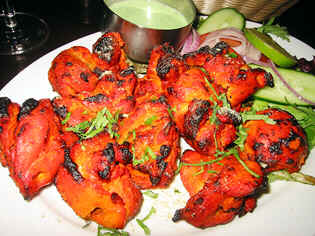Dr. Vikas Mahajan
 For non-vegetarians, chicken forms an essential component of diet. But there are many questions related to chicken meat which need to be answered.
For non-vegetarians, chicken forms an essential component of diet. But there are many questions related to chicken meat which need to be answered.
Is Chicken is largely responsible for food-borne illnesses in this country.
Fact: According to CDC, fish/shellfish (19%), beef (7%), fruits and vegetables (7%) were ahead of chicken (3%) as causes for food-borne illnesses in which the contaminated food was identified. The few cases of food-borne illness associated with chicken can be avoided by proper handling and cooking. Controlling food-borne illness requires prevention efforts among all food commodities as well as proper food handling.
Is Boneless, skinless chicken breast the healthiest of all chicken parts?
Fact: It might be the lowest in total fat, but, chicken thighs are popular with chefs as they are more flavorful than white meat; nutritionists like dark meat because it has 24% more iron and 3 times the zinc as white meat. Iron and zinc are two nutrients that are often low in the diets of children and adolescent girls so break out of the white meat chicken rut and try boneless chicken thighs or drumsticks. Kids love drumsticks–they come with their own handle.
Does Hormone use in poultry production pose a health risk to consumers?
Fact: Law prohibits the use of hormones in poultry production. This is clearly stated on package labels when a “no added hormone” claim is made. Polling data showed that many consumers were confused about when hormones were used in poultry production and about their safety. It is important to understand that all multi-cellular organisms contain hormones, whether they are eggs, soybeans or people. No food or living thing can be “hormone-free,” despite marketing claims that may suggest this to be so. Poultry can be grown without added hormones, but they cannot be hormone-free.
Always buy chicken labelled as “hormone free” or “natural” to get the healthiest bird for your family.
Fact: The truth is that the word “natural” means nothing on a food package and no hormones are used in any chicken products. So, saying a package of chicken breasts is hormone-free is like saying that bag of potato chips has no cholesterol–no potato chips contain cholesterol (cholesterol is found only in animal foods) and no chicken sold in the INDIA is fed hormones to fatten it up. You may prefer to buy organic poultry but you don’t have to spend extra money to get hormone-free chicken.
Antibiotic usage in poultry is creating disease resistant bacteria that threaten human health.
Fact: Antibiotics approved by the FDA have been used safely for more than 40 years resulting in healthier animals and people. Only veterinarians can prescribe animal antibiotics.
Chickens are fed antibiotics to make them grow faster and larger which causes harm to human.
Fact: The improvements in growth rates achieved over the years are not due to antibiotics. Antibiotics have an important role to play in ensuring the health of chickens; healthy birds are naturally more likely to grow better and more efficiently than birds that are unhealthy.
The use of antibiotics in two important and responsible ways:
* Therapeutic agents – used to treat bacterial infection in sick birds
* Preventative agents – used to prevent disease occurring in healthy animals.
The law does not approve of using antibiotics for the purpose of growth promotion. This ensures that no residue of antibiotics remains in chicken meat offered for sale.
Whether Meat chickens are genetically modified and that genetic modification of birds has contributed to the change in size ?
Fact: Chickens are not genetically modified. Improvements in their growth, feed conversion efficiency, tenderness and other characteristics are entirely due to traditional breeding techniques that is, selecting only the fittest, most efficient and strongest birds to produce the next generation. Bird size has increased significantly due to advances in breeding, animal nutrition and animal care that ensure that only the heartiest birds with the greatest potential to yield the most food are produced.
Is higher intake of poultry cause of colorectal cancer risk ?
Fact: Higher intake of poultry and fish may be associated with a lower risk of colorectal cancer.
Is all chicken pumped full of sodium-containing liquids ?
Fact: Some chicken contain liquid that can increase the sodium content, but not all. If you are reducing sodium look at the label to find out if the product is “enhanced” or “marinated” which might indicate there is added sodium.
Chicken skin should always be removed before cooking.
Fact: Cooking chicken with the skin on helps seal the juices and makes the chicken meat more tender and flavourful. More than half of the fat in chicken skin is mono-unsaturated fat-the healthy kind of fat. So, leave the skin on when cooking and remove the skin at the table to cut extra calories while saving flavor.
All wild waterfowl carry Avian Influenza virus.
Fact: Different strains of Avian Influenza (AI) virus occur naturally in some wild waterfowl and shorebirds without causing illness or death. Although wild waterfowl and shorebirds are considered natural reservoirs of AI viruses, only the H5 and H7 subtypes can infect domestic poultry. Very few wild waterfowl and shorebirds carry the H5 or H7 subtypes of AI virus. Infection of INDIAN domestic poultry with AI through contact with wild waterfowl and/or shorebirds is highly unlikely due to closed confinement and strict bio-security practices.
May I get Avian Influenza by eating or handling poultry products?
Fact: There is no danger of acquiring Avian Influenza (AI) by eating or handling properly processed poultry products. AI virus is easily destroyed by the heat of normal cooking. AI-infected or even suspect poultry will not be sold in the INDIA because of strict disease surveillance and food inspection systems. The INDIA does not import poultry or poultry products from countries affected with bird flu.
Trending Now
E-Paper

